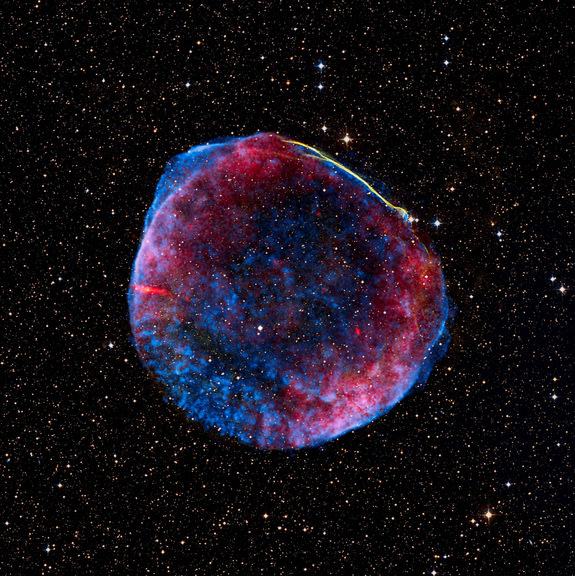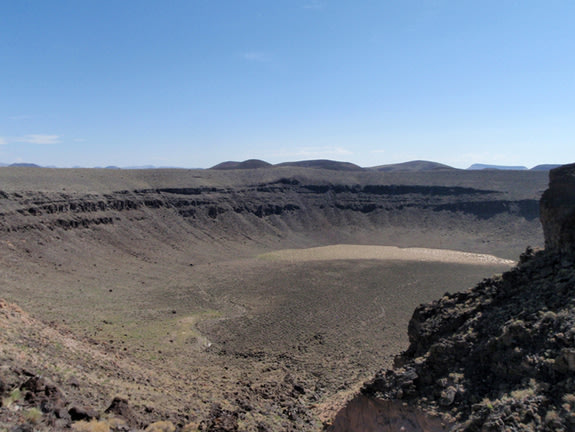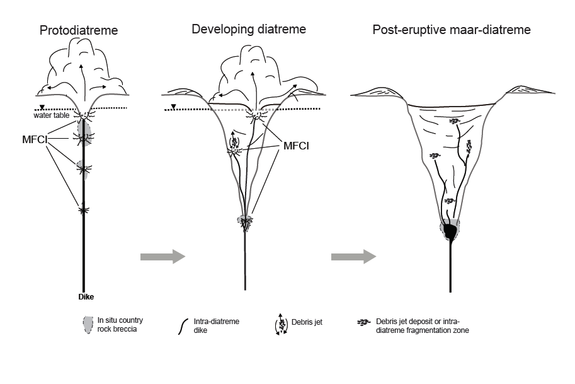Search This Blog
Saturday, October 6, 2012
Brightest Star Explosion in History Reveals Lonely Supernova
The brightest exploding star ever seen with the naked eye in recorded history apparently experienced a quick and lonely death, a new study reveals.
The discovery, which centered on a star explosion witnessed in the year 1006, suggests that many similar outbursts leave no companion star to accompany their demise.
The most powerful exploding stars in the universeare supernovas, which are bright enough to momentarily outshine their entire galaxies. One type of star explosion, known as a Type 1a supernova, occurs when one star pours enough fuel onto a dying companion star known as a white dwarf to trigger an extraordinary nuclear explosion.
The new study centered its sights on the supernova SN 1006, which was seen all over Earth in the spring of 1006 above the southern horizon of the night sky, in the constellation Lupus, just south of Scorpio. At its peak, researchers say the supernova, which exploded about 7,100 light-years away, was about one-quarter the brightness of the moon, luminous enough that people could have read by its light at midnight
Maar Volcanoes: Odd Explosions Beneath Earth Explained
The eruption of a so-called maar-diatreme volcano is short-lived but violent. Magma creeps up through a crack in the Earth's crust and mixes with water, setting off a series of explosions — as many as a few each hour for several weeks. When the action stops, a crater-topped, rock-filled fracture called a diatreme is left behind.
Now researchers are proposing a new way to think about how these structures are formed, which could help geologists predict eruptions and find new sources of diamonds.
"Previously it was thought that those explosions started at very shallow levels and got progressively deeper," geologist Greg Valentine, a professor at the University at Buffalo in New York, told LiveScience.
This old model seemed to explain the shape of a diatreme, which sits like an inverted cone beneath a shallow maar, or crater. But that model didn't match with what geologists were finding at volcanic sites, Valentine said.
If the explosions started at shallow levels and moved deeper, shallow rocks would be spewed from the mouth of the volcano first and the deeper rock deposits would pile up on top. At maar sites, however, scientists were finding deep rock fragments mixed mostly with shallow fragments, indicating that explosions occur at essentially every depth throughout the episode. [50 Amazing Volcano Facts]
Valentine and James White, an associate professor at the University of Otago in New Zealand, created a new model to account for the apparently more jumbled order of explosions. Their model, published online Sept. 18 by the journal Geology, also shows that individual explosions are relatively small, and shallow explosions are more likely than deep explosions to cause eruptions.
The last known maar-diatreme eruption occurred in 1977 in Alaska's remote Aleutian Range, forming two vents known as the Ukinrek Maars. The threats associated with these volcanoes tend to be localized, but they can still be significant, Valentine said.
"These volcanoes can send ash deposits into populated areas. They could easily produce the same effects that the one in Iceland did when it disrupted air travel, so what we're trying to do is understand the way they behave," he explained in a statement.
In another practical application for the model, Valentine said a better understanding of these volcanoes could help find diamonds. Diatremes are sometimes formed by a type of molten rock known as kimberlite, which has the deepest origins of all magmas on Earth. When this magma cools, it leaves behind rocks dense in crystals, sometimes holding diamonds.
This past summer, Valentine and his colleagues in Buffalo simulated maar eruptions, burying and detonating explosives and then examining the craters. He said he is planning similar experiments for next summer to test out his new model.
Calif. gas prices hit all-time high
LOS ANGELES (AP) — It's a record, though just barely. The price of gasoline hit an all-time average high in California of $4.6140 a gallon Saturday, fueled by a reduced supply and a volatile market.
The record was set by a fraction of a penny, according to AAA spokesman Michael Green. The previous high was $4.6096 on June 19, 2008.
Prices throughout the state were expected to increase for several more days before leveling off, after a temporary reduction in supply triggered a price spike that saw fuming motorists paying $5 or more per gallon in some locations and station owners shutting down pumps in others.
AAA's Daily Fuel Gauge report released Saturday said the average price for a gallon of regular unleaded across California rose 12 cents from its Friday mark of about $4.49.
Saturday's price was the highest in the nation, with the Golden State leapfrogging Hawaii this week as the state with the most expensive fuel. The average price for a gallon of regular unleaded across California was 47 cents more than a week ago, according to the AAA report.
"I seriously thought it was a mistake on the sign when we pulled in," said Nancy Garcia, 34, while filling her Honda Accord at a Chevron station in the Los Angeles neighborhood of Highland Park. She paid $4.65 a gallon for regular grade and said she couldn't afford to fill her tank all the way.
When supplies drop, wholesale prices rise. Then distributors and station owners have to pay more to fill up their station's tanks. They then raise their prices based on how much they paid for their current inventory, how much they think they will have to pay for their next shipment, and, how much their competitors are charging.
The national average Saturday was about $3.81 a gallon, the highest ever for this time of year. However, gas prices in many other states have started decreasing, which is typical for October.
The dramatic surge came after a power outage Monday at a Southern California refinery that reduced supply in an already fragile and volatile market, analysts said, but the refinery came back online Friday and prices were expected to stabilize by next week.
Patrick DeHaan, senior petroleum analyst at GasBuddy.com, predicted the average price could peak as high as $4.85.
"There is some relief in sight but probably not for a couple of days. Early next week is when we may see some more significant declines ... but at retail prices, prices may climb for the next two to three days before they start to come down," he said.
While prices were higher everywhere in California, there were variances Saturday. Chico had the lowest average price at $4.46, according to AAA, while San Luis Obispo was highest at $4.71. Prices averaged $4.67 in San Diego, $4.66 in the Los Angeles area, $4.55 in Fresno and $4.49 in Sacramento.
The price of diesel has also increased, adding significant costs for truckers who typically put hundreds of dollars of fuel in their tanks. It's gotten so bad, some truckers may stop driving altogether, said Michael Shaw, spokesman for the California Trucking Association, whose members move 80 percent of the cargo on California's roads each year.
"The fluctuation and rapid increase of prices makes it difficult to plan ahead and take on new contracts," he said. "It's difficult to operate in that environment."
A web of refinery and transmission problems is to blame, analysts said. The situation is compounded by a California pollution law that requires a special blend of cleaner-burning gasoline from April to October, said Denton Cinquegrana, executive editor of the Oil Price Information Service, which helps AAA compile its price survey.
"We use the phrase 'the perfect storm,' and you know what, this current one makes those other perfect storms look like a drizzle. I don't want to scare anyone, but this is a big problem," Cinquegrana said. "Run-outs are happening left and right."
Among the recent disruptions, an Aug. 6 fire at a Chevron Corp. refinery in Richmond that left one of the region's largest refineries producing at a reduced capacity, and a Chevron pipeline that moves crude oil to Northern California also was shut down.
There was some good news, however.
Exxon Mobil Corp. said a refinery in Torrance returned to normal operations Friday after the power failure Monday disrupted production for most of the week. State officials said with the refinery coming back online, prices should start falling.
Gasoline inventories in California, however, are still at their lowest point in more than 10 years, a situation made worse by the mandate for the special summer gasoline blend. Few refineries outside the state can make it, meaning there are few outside sources to draw from for help, Cinquegrana said.
The California Air Resources Board was reviewing a request from the California Independent Oil Marketers Association for a waiver that would allow gas stations to begin selling winter-blend gasoline before Halloween.
Some stations ran out of gas and shut down rather than take the risk of buying gas at soaring prices only to be stuck with a glut of overpriced fuel if prices dropped or if customers refused to absorb the extra cost that would be passed along to them.
Mark Mitchell, co-owner of the Coast Oil fuel distributorship in San Jose, told the San Francisco Chronicle that none of the gas stations he serves had shut down, although some station owners had discussed it. When spot prices hit their peak, the stations would need to charge about $4.89 to break even, he said.
"We get the gas — it's just at what price?" Mitchell told the newspaper. "You're not going to sell much when it goes up 40 cents in a day."
___
Extradited terrorism suspects appear in US courts
NEW YORK (AP) — A partially blind extremist Egyptian-born preacher charged in multiple terrorism plots entered a U.S. court for the first time Saturday without the use of his arms, complaining that prosthetic hooks he uses were taken away as he and four other terrorism defendants were flown to New York overnight from London.
Abu Hamza al-Masri, 54, indicted under the name Mustafa Kamel Mustafa, entered a Manhattan courtroom under heavy security to face charges he conspired with Seattle men to set up a terrorist training camp in Oregon and helped abduct 16 hostages, two of them American tourists, in Yemen in 1998.
Al-Masri came into court with both arms exposed through his short-sleeved blue prison shirt. His court-appointed lawyer, Sabrina Shroff, asked that his prosthetics be immediately returned "so he can use his arms."
In the 1990s, al-Masri turned London's Finsbury Park Mosque into a training ground for extremist Islamists, attracting men including Sept. 11 conspirator Zacarias Moussaoui and "shoe bomber" Richard Reid.
His court appearance followed soon after two other defendants brought to New York, Khaled al-Fawwaz and Adel Abdul Bary, entered not guilty pleas to charges that they participated in the bombings of two U.S. embassies in Africa in 1998.
The attacks killed 224 people, including 12 Americans. They were indicted in a case that also charged Osama bin Laden.
In New Haven, Connecticut, earlier in the day, Syed Talha Ahsan, 33, and Babar Ahmad, 38, entered not guilty pleas to charges that they provided terrorists in Afghanistan and Chechnya with cash, recruits and equipment. All five of the men face up to life in prison if they are convicted.
Al-Masri, a one-time nightclub bouncer, entered no plea, saying only "I do" when he was asked by U.S. Magistrate Judge Frank Maas whether he swears that his financial affidavit used to determine is he qualifies for a court-appointed lawyer was correct.
Shroff told Maas that al-Masri needed use of his arms. "Otherwise, he will not be able to function in a civilized manner."
She also asked for a dictating machine, saying he can't take notes, and the return of his diabetes medication and special shoes that prevent him from slipping. She said he will need a special diet in prison and a full medical evaluation.
His beard and hair white, al-Masri peered through glasses as he consulted with Shroff and another court-appointed lawyer, Jerrod Thompson-Hicks, in a proceeding that lasted less than 15 minutes.
Al-Masri has one eye claims to have lost his hands fighting the Soviets in Afghanistan. His lawyers in England said he suffers from depression, chronic sleep deprivation, diabetes and other ailments.
Outside court, Shroff took note of her client's condition, saying: "I don't think he slept at all." Still, she added, "He seemed very much like a gentleman."
She said she did not believe he had eaten since arriving on a flight with the others at about 2:40 a.m.
Shroff and Thompson-Hicks also represented al-Fawwaz, 50, a citizen of Saudi Arabia. Thompson-Hicks said he was concerned whether his client would be properly treated for hypertension and high blood pressure. Attorney Andrew Patel, representing Bary, 52, an Egyptian citizen, said his client needed asthma medicine and treatment for other medical issues.
Patel, who declined to comment afterward, told Maas that Bary reserved the right to request bail in the future.
Four others who were tried in 2001 in the August 1998 bombings in Kenya and Tanzania are serving life sentences.
Ahsan, 33, and Ahmad, 38, were kept detained while they await trial in Connecticut, where an Internet service provider was allegedly used to host a website. Their lawyers declined to comment.
Ahmad made efforts to secure GPS devices, Kevlar helmets, night vision goggles, ballistic vests and camouflage uniforms, prosecutors said.
U.S. Attorney Preet Bharara called the extraditions "a watershed moment in our nation's efforts to eradicate terrorism."
He added: "As is charged, these are men who were at the nerve centers of Al Qaeda's acts of terror, and they caused blood to be shed, lives to be lost, and families to be shattered."
Al-Masri is not the first ailing Egyptian-born preacher to be brought to Manhattan for trial. A blind sheik, Omar Abdel-Rahman, is serving a life sentence after he was convicted in 1995 in a plot to assassinate then-Egyptian President Hosni Mubarak and in another to blow up New York landmarks, including the United Nations and two tunnels and a bridge linking New Jersey to Manhattan. Abdel-Rahman has numerous health issues, including heart trouble.
The overnight trip to the United States came after a multiyear extradition fight that ended Friday, when Britain's High Court ruled that the men had no more grounds for appeal and could be sent to the U.S. immediately. The men have been battling extradition for between eight and 14 years.
"I'm absolutely delighted that Abu Hamza is now out of this country," British Prime Minister David Cameron said. "Like the rest of the public I'm sick to the back teeth of people who come here, threaten our country, who stay at vast expense to the taxpayer and we can't get rid of them."
"I'm delighted on this occasion we've managed to send this person off to a country where he will face justice," he added.
Al-Masri has been in a British jail since 2004 on separate charges of inciting racial hatred and encouraging followers to kill non-Muslims.
While al-Masri has been portrayed in the British media as one of the most dangerous men in the country, the case against Ahmad in Connecticut has raised concerns among legal experts and human rights advocates.
Some lawyers and lawmakers have expressed concerns because Britain agreed to extradite the London computer expert even though his alleged crimes were committed in Britain and British courts declined to prosecute him for lack of evidence. Ahmad and Ahsan are accused of running websites to support Afghanistan's ousted Taliban regime, Chechen rebels and associated terrorist groups.
___
Avoid excess coffee to keep vision sharp and ward off eye disease
A new study suggests limiting caffeine intake to avoid developing serious eye disease and vision loss after finding a link between coffee drinking habits and glaucoma.
Based on previously reported findings among Scandinavian populations, US researchers from Harvard University carried out a meta-analysis examining the profiles of about 120,180 men and women aged 40 and older who provided information on their caffeinated beverage intake.
Responses were compared against their medical records to determine the cases of exfoliation glaucoma, which contributes to elevated pressure and can lead to damage of the optic nerve.
Exfoliation glaucoma occurs when a whitish material builds up on the lens of the eye and, as its name implies, exfoliates or rubs off the color of the iris, blocking fluids from leaving the eye.
Results showed that compared to non-caffeinated coffee drinkers, participants who drank three or more cups a day were at an increased risk of developing the eye disease. Interestingly, scientists say they found no associations with the consumption of other caffeinated beverages such as soda, tea, chocolate or decaffeinated coffee.
The US study, published in the journal Investigative Ophthalmology & Visual Science, builds on previously reported studies which found a link between the caffeinated coffee consumption of Scandinavians and the increased risk of developing eye disease: Scandinavian populations have the highest rates of exfoliation glaucoma and also happen to be the highest coffee consumers in the world, researchers said.
The health findings surrounding coffee are mixed, as another study suggests that caffeinated coffee could lower the risk of the most common form of skin cancer, basal cell carcinoma, while another study claims that coffee drinkers have a lower rate of death from heart disease.
Pinay teen wins 2012 covergirl search for Seventeen Magazine-Malaysia Pinay teen wins 2012 covergirl search for Seventeen Magazine-Malaysia
Sixteen-year old Filipina Erika Magora recently won the 2012 Covergirl Search of the Malaysian edition of Seventeen Magazine.
In a news release on Friday, the Philippine Department of Foreign Affairs (DFA) said Magora was born of Filipino parents and grew up in Valenzuela City.
She arrived in Malaysia in 2008 with her mother and grandmother, and speaks fluent Malay, English, and Filipino.
Magora studies in a private school in Subang Jaya, Selangor, and is always a top student in her class. The DFA said she intends to pursue law studies in college.
Magora's hobbies include playing the guitar, singing, surfing the net, and reading books.
Last January, Magora attended an event entitled “Clinique Sweet Seventeen Makeover Party” organized by Seventeen Malaysia.
During the event, one of the magazine editors spotted her and invited for a photo shoot for their June 2012 issue.
In April, she also joined the Seventeen Covergirl Search 2012.
"Because of her charm and beauty, she stood out from all other contestants and won the contest. She then appeared in the magazine’s October 2012 issue, together with Malaysian pop star Mizz Nina," the DFA said.
Magora paid a courtesy call on Philippine Ambassador to Malaysia Eduardo Malaya on October 1 with her mother, Anne Patricia Magora.
Malaya congratulated Magora for her victory and urged her to remain a well-rounded individual.
“Do continue to be a pride of your Filipino heritage, and show to them the beauty, spirit and other positive Filipino traits. Also, be a good example to your fellow teenagers on what they can strive to be,” he said.
Russian boy discovers wooly 'mammoth of the century'
An 11-year-old boy from Russia's north has stumbled upon a well-preserved wooly mammoth, in what scientists describe as the best such discovery since 1901.
Yevgeny Salinder, whose family lives near a polar station in the northern Taimyr Peninsula, discovered the frozen animal when he was strolling along the banks of the Yenisei River in late August.
"He sensed an unpleasant odour and saw something sticking out of the ground -- it was the mammoth's heels," said Alexei Tikhonov, director of the Saint Petersburg-based Zoological Museum, who rushed to the tundra after the boy's family had notified scientists of the historic find.
Tikhonov said the mammoth had died aged 15-16 around 30,000 years ago, adding his tusk, skin, an eye and an ear were clearly visible.
"His one-metre-long penis is also intact so we can conclude that this was a male," Tikhonov told AFP.
Tikhonov said it was the best preserved adult mammoth discovered in more than 100 years.
"So far we can say it is the mammoth of the century," Tikhonov said.
It took scientists five days to dig out the animal which was then transported to the northern city of Dudinka.
Subscribe to:
Comments (Atom)
















